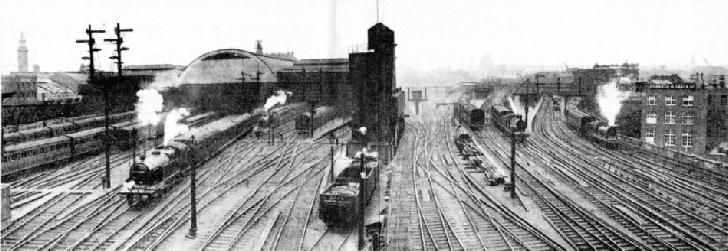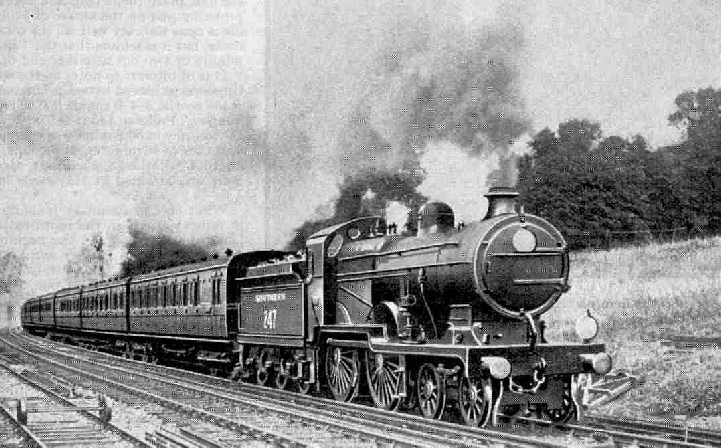
© Railway Wonders of the World 2012-


The “Folkestone Flyer”
A Famous Train of the Southern Railway

Latest type “L” class 4-
WHAT an extraordinary revolution has taken place in railway travel in the south-
Since the war, while the great trunk lines to the North of England have been content, in the main, gradually to restore their pre-
The distance from Charing Cross to Folkestone Central is almost exactly 70 miles, giving an average booked speed of 52½ m.p.h. from start to stop. But when allowance is made for the slow exit round all the sharp curves from Charing Cross to London Bridge, for the congestion of the suburban area, for the tremendous climb from New Cross to Knockholt and, last of all, for the severe slack round the curve through Tonbridge Junction just when the speed ruling is high, it will be seen that there is no time to spare. In fact the average rate over rate over the dead straight and well-
While the speed of these trains has been going up, so the weight of them has been constantly on the increase also. The latest 32-
There are actually four trains timed to make the 80–minute run between Charing Cross and Folkestone. The 4.15 p.m. and the 7.15 p.m. are the two down expresses so booked, and the two up trains leave Folkestone Central at 11 in the morning and 5.10 in the evening. The 9 o’clock up makes London Bridge in the same time, but in this case, of course, the distance covered is not quite so great. As most of our journeys in these articles have been made from London, it will be somewhat of a novelty to take the up journey for once, and we will therefore imagine ourselves at the Central Station at Folkestone somewhere about 5 o’clock in the evening ready to make the dash for town at 5.10 p.m.
Part of the train we shall find already waiting in the bay platform, consisting probably of two corridor third-

Parallel tracks, south of London Bridge, Southern Railway. The Folkestone 80-
Some tremendously fast running lies immediately ahead of us. From Folkestone to Tonbridge the distance is 40½ miles, but according to the timetable we must pass Tonbridge Junction at 5.51 p.m. – that is, 40½ miles in 41 minutes from the start. To make matters more difficult, we have ahead of us, for five miles out of Folkestone to just beyond Sandling Junction, a continuous rise at 1 in 264. But all the way up this we shall find our engine steadily accelerating, and we shall probably get through Sandling, 4½ miles, at a speed of between 40 and 45 miles an hour, in some eight minutes from the start.
Now the galloping begins. There is a gentle down gradient from Westenhanger to Ashford, not steeper than 1 in 266 at any point, but the speed will rise until, probably we are well above the “70” line, and our headlong dash past the locomotive works and through Ashford Junction will be thrilling indeed. Then follows a faint rise to a siding called Chart, after which are further faintly falling grades to Pluckley, and gentle ups-
From Paddock Wood there is a rise towards Tonbridge, and immediately we have breasted it there comes the shutting off steam and the slowing for Tonbridge Junction, to 35 m.p.h. It could not come at a worse place, as we want all the impetus we can get here for the tremendous climb that follows immediately, up to Sevenoaks. For four miles, past Hildenborough to the mouth of the tunnel, it is at 1 in 122, and then, through the two miles of the tunnel itself, there is an easing of 1 in 144. On the ascent the speed will gradually fall, until we shall enter the tunnel, probably, at a little under rather than over 30 m.p.h., and shall maintain this same speed, roughly, up to the tunnel exit.
Rapidly we gather speed through the deep chalk cutting to Sevenoaks Station and onward to the bottom of the valley between there and Dunton Green, where climbing recommences. This final stretch of the ascent to Knockholt (two miles at 1 in 143), is not quite so steep as that from Tonbridge. After having touched about a mile-
Knockholt Station, at about 40 m.p.h. or slightly over. Although we have covered the 36 miles from Sandbridge to Ton-
But the engine’s hard work is pretty well over. All the way to New Cross we have now falling, and for the most part steeply falling grades ahead, though the driver dare not make full use of his opportunities, owing to the shortness of the signal sections and the possibility of signal checks in the congested suburban area we have now entered. We shall “ease” over the junctions at Orpington, but on the steepest part of the descent, from Elmstead Tunnel down to Hither Green, it is possible we may again exceed 70 an hour before the enforced slowing over the curve through St. John’s.
If we are lucky, we may get through to Charing Cross without a signal check, but so crowded with trains is this maze of lines that it is hardly surprising if we fail to get an absolutely clear road. Still, our driver will probably contrive to keep his train on the move, without any stop or very severe slowing, though the curves between London Bridge and Charing Cross are so sharp that they must be negotiated with caution. So we roll over Charing Cross Bridge, and we may expect duly to come to rest at our platform at 6.30 p.m.
Although we have probably done enough travelling for the day, our train has not, and three-
The problems that confronted the Southern Railway at the inception of the grouping scheme were enormous. All through the war years, and for a considerable period afterwards, its tracks and rolling stock had borne the strain of carrying men, munitions and war equipment of all kinds to and from the embarkation ports, and complete reconstruction was essential. For a time all appeared to be confusion, but gradually the bold policy adopted proved successful. Considerations such as these make the running times of the “Folkestone Flyer” all the more meritorious.

“Kent Coast Express”, Eastern Division Southern Railway. The engine seen is similar in type, but rather smaller than the latest superheated “L” class locomotives.
You can read more about “The Dover Pullman Boat Express” , “The Golden Arrow” and “The Southern Belle” on this website.